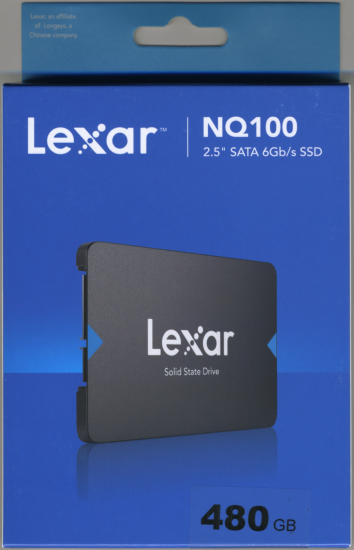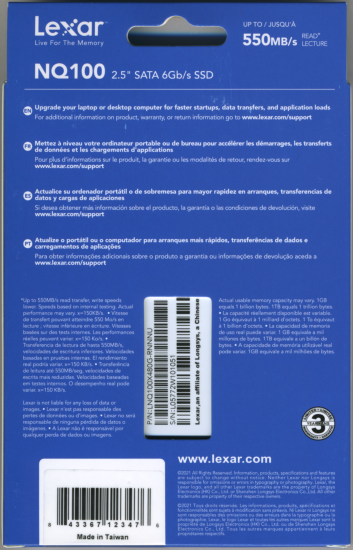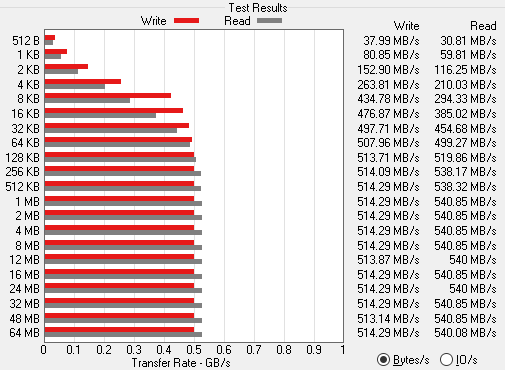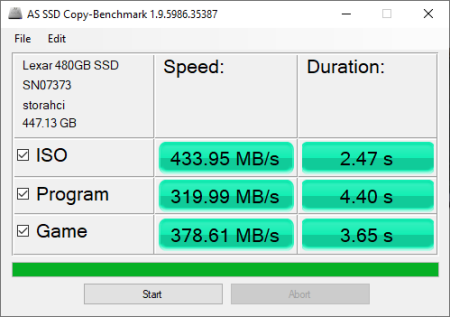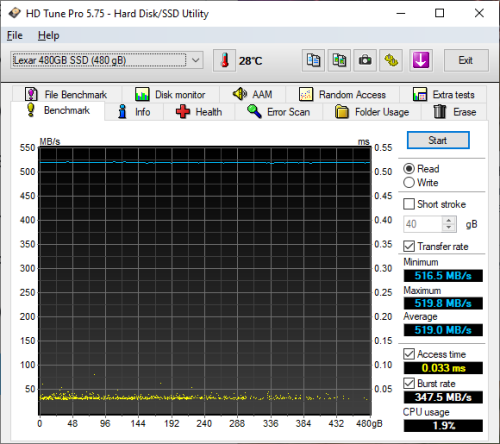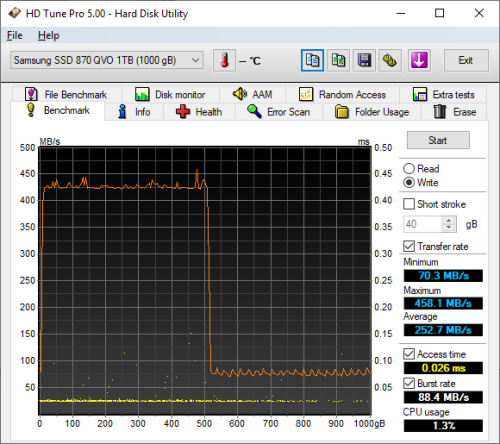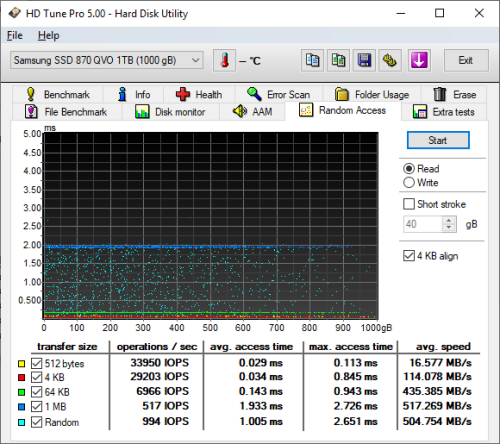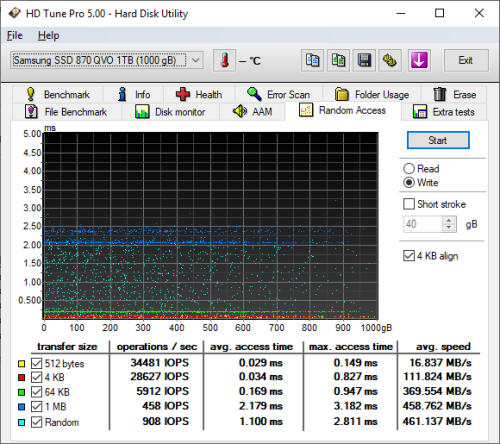

Model: Lexar NQ100 480GB Solid State Drive
Manufacturer: Lexar
Provided By: Lexar
Lexar has been a trusted name in the storage industry for more than 20 years. The company got its start as a division within Cirrus Logic before being spun off in 1996. Lexar quickly made a name for itself thanks to its USB and ATA controllers as well as its industry-leading memory cards and USB flash drives. In 2006, the company was acquired by Micron and merged with Crucial Technology under the name Lexar Media. Lexar continued to flourish under Micron but, in 2017, its parent company decided to get out of the removable media storage business. The Lexar brand was then acquired and relaunched by Shenzhen Longsys Electronics Co., Ltd. (Longsys) with a new product lineup including memory cards, card readers, USB flash drives and SSDs geared towards professional photographers, videographers and content creators.
This past winter, Lexar unveiled its latest SATA SSD, the NQ100. Aimed at everyday end-users looking to upgrade their laptop or desktop computer, the drive combines Lexar's DM928 controller with Micron's TLC NAND flash to deliver read speeds of up to 550MB/s for faster startups, data transfers and application load times. With no moving parts, the NQ100 SSD is also shock and vibration resistant, making it more reliable and durable than a typical hard drive. In addition, it offers cool, quiet operation and low power consumption for longer battery life.
The NQ100 is available in 240GB, 480GB and 980GB capacities. For this review, Lexar sent us the 480GB version of the drive which is capable of delivering up to 560 MB/s sequential read and 480 MB/s sequential write speeds.
| Lexar NQ100 480GB Solid State Drive | |||||||||||||||||||||||||||||||||
General Specifications
Performance
Reliability
Environmental
Dimensions and Weight
Other Features
|
Needless to say, this is only a taste of what the NQ100 has to offer. To give you an idea of what to expect, we'll take a closer look at Lexar's new SATA SSD and then see how well it performs. Does the NQ100 have what it takes? More importantly, is it the best bang for your buck? Keep reading as we find out.
The NQ100 comes in a small, blue box. Along with a picture of the drive, the packaging advertises a number of its key features including its 480GB capacity, SATA 6Gbps interface and 550 MB/s read speed. The back of the box also has a small window that lets you see the drive and view the part and serial numbers. Inside, you'll find the SSD as well as a fold out guide containing warranty information and some brief installation instructions.
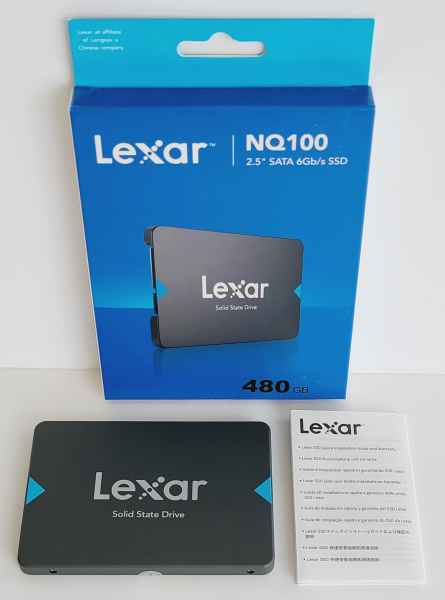
Physical Features:
The NQ100 looks very similar to Lexar's other 2.5-inch SSDs. The drive's outer casing is made out of gray plastic and is covered by a nice textured finish. On the top, there is also a large Lexar logo as well as a light blue triangle on either side of the SSD.
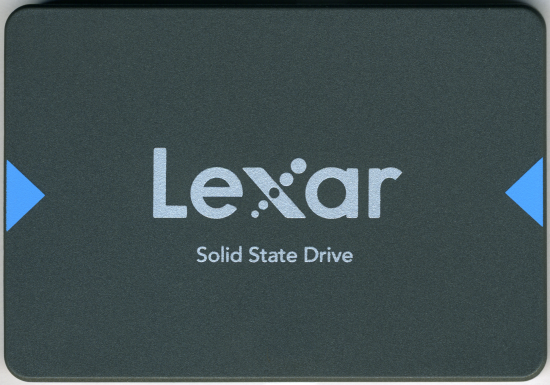

The NQ100 uses a Lexar branded DM928 controller chip. I wasn't able to find any information regarding this controller online. However, going by the size of the chip and the firmware version (SN07373) we can assume that it is based on the Maxio MAS1102. This DRAM-less SATA controller supports two channels with up to 8 chip enables (CE) per channel.


For the 480GB version of the NQ100, Lexar has opted to use Micron's 3D TLC NAND flash. Looking at the picture above, you can see that there are two 128GB NAND flash packages on either side of the PCB. Also take note that there is no DRAM cache chip. Instead, there is small DRAM cache embedded in the controller.
The test system used in this review is equipped with an AMD Ryzen 3 3100 CPU, MSI B550 GAMING PLUS motherboard, 16GB (8GB x 2) of Crucial Ballistix 3200 MHz DDR4 memory, Crucial P5 1TB SSD and a GIGABYTE GeForce GTX 1060 WINDFORCE OC 6G graphics card. For the operating system, I used the latest version of Windows 10 Pro.
To test the performance of Lexar's NQ100 SSD, I ran a series of benchmarks using CrystalDiskMark, HD Tach RW, ATTO Disk Benchmark, AS SSD, HD Tune Pro, Anvil's Storage Utilities, Iometer and PCMark 8. For comparison, I've also included test results from the Samsung 870 EVO, Samsung 870 QVO, SK hynix Gold S31, ADATA Ultimate SU750, Samsung 860 QVO, Samsung 860 PRO, Crucial MX500, Plextor M8V, Crucial BX300, ADATA Ultimate SU900, Plextor S3C, Toshiba OCZ VX500, ADATA Ultimate SU800, Plextor S2C, Crucial MX300, Plextor M7V, PNY CS1311, OCZ Trion 150, PNY CS2211, Plextor M6V, Crucial BX200, OCZ Trion 100, Kingston HyperX Savage, Crucial MX200, OCZ Vector 180, Kingston BX100, Samsung 850 EVO M.2, Samsung 850 EVO mSATA, AMD Radeon R7, Silicon Power Slim S80, Samsung SSD 850 EVO, OCZ ARC 100, SanDisk Ultra II, Crucial MX100, SanDisk Extreme Pro and Samsung SSD 850 PRO.
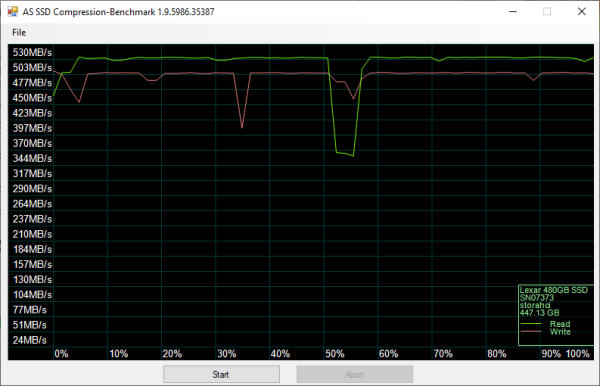
As I mentioned earlier, the NQ100 uses Samsung's MKX controller chip. Looking at the screenshot above, you can see that it performs equally well with both incompressible (0%) and compressible (100%) data.
CrystalDiskMark 8.0.1:
First, I ran a few quick tests using CrystalDiskMark. This benchmark measures the performance of a storage device by testing its sequential and random read and write speeds. For this test, we're using the peak and real world profiles.

According to Lexar, the 480GB version of the NQ100 is capable of reading at 560 MB/s and writing at 480 MB/s. As you can see, the drive had no problems reaching these speeds in CrystalDiskMark's sequential read and write tests.
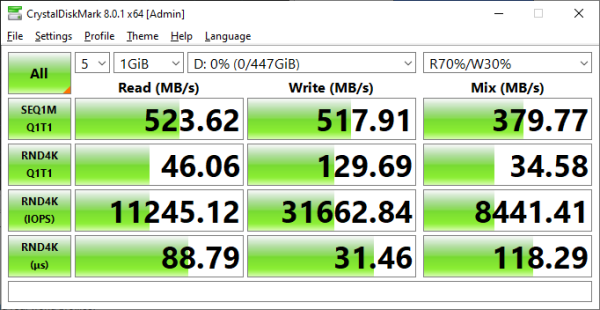
As you'd expect, the NQ100 wasn't nearly as fast when tested with the "real world" profile which uses a single thread and a much lower queue depth. Nevertheless, it was still able to read at 523 MB/s and write at more than 517 MB/s.
HD Tach RW 3.0.4.0:
Next, I used HD Tach to test the NQ100's read, write and burst speeds as well as its seek times and CPU usage.

Looking at the screenshot above, you can see that the NQ100 had average read and write speeds of 417.4 MB/s and 457.3 MB/s respectively, as well as a burst speed of 479.1 MB/s.
ATTO Disk Benchmark 4.01:
I also used ATTO Disk Benchmark to test the NQ100's sequential read and write speeds. The tests are run using blocks ranging in size from 512B to 64 MB and the total length set to 256MB.
When tested with ATTO, the NQ100's read speeds topped out at about 540 MB/s and its write speeds at 514 MB/s.
AS SSD:
AS SSD is a benchmark designed specifically for solid state drives. The application contains five synthetic tests which are used to determine the sequential and random read and write performance of a drive.
AS SSD also includes a copy benchmark. This test copies an ISO (two large files), program (many small files) and game (small and large files), returning the speed and duration of each.
HD Tune Pro 5.00:
Next, I ran a series of tests using HD Tune Pro. This hard disk utility measures a drive's performance by testing its sequential read and write speeds as well as its access time, burst rate and CPU usage. For this review, I'm also going to use it to benchmark the NQ100's random read and write speeds, random access times and the number of operations per second.
The NQ100 performed relatively well when benchmarked with HD Tune. The drive had average read and write speeds of 519.0 MB/s and 503.9 MB/s, respectively.
When reading 4KB blocks, the NQ100 reached 24,576 IOPS and had an average speed of 96.003 MB/s. The drive was faster when writing, reaching 30,819 IOPS with an average speed of 120.389 MB/s.
Anvil's Storage Utilities:
Anvil's Storage Utilities is another benchmark designed with SSDs in mind. The standard storage benchmark measures a drive's performance by testing its transfer speeds, access times and IOPS.

Iometer:
Lastly, I ran a series of tests using Iometer. This tool can be configured to benchmark a number of things. In this case, I used it to measure the NQ100's read and write speeds and the number of operations per second. The tests were run using random bytes and a queue depth of 3.

The NQ100's performance was very similar to what we saw in our other tests. The drive was able to read at 540.15 MB/s and write at 462.96 MB/s.

The NQ100 wasn't one of the faster drives we've tested when it came to random reads and writes. In our tests, the drive was able to read at 117.18 MB/s and write at 255.49 MB/s.

Lexar really doesn't say what the NQ100 is capable of in regards to IOPS. In our tests, the drive reached 29,997 random read IOPS and 65,406 random write IOPS. Increasing the queue depth had little impact on the NQ100's random write performance. However, with four threads and the queue depth set to 32, the drive was able to reach 53,650 random read IOPS.
Vantage PCMark 8 - Storage Test:
PCMark 8 is a complete benchmark for Windows. It includes five benchmark tests, each designed around a specific scenario. The storage benchmark measures drive performance using real-world traces recorded from Adobe Creative Suite, Microsoft Office and a selection of popular games.
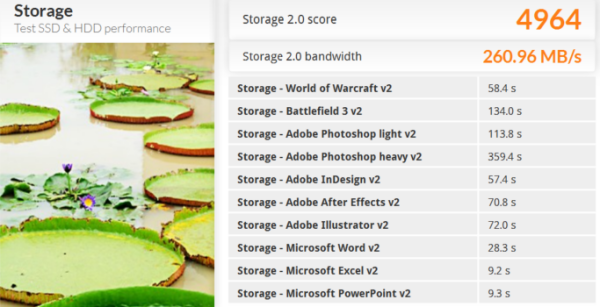
PCMark 8 also includes a consistency test which measures the performance consistency and degradation tendency of a storage system. The test reports the performance level at the start, the degraded steady-state and the recovered state as well as the number of iterations required to reach them. For this test, we are focusing on the Adobe Photoshop (Heavy) trace and will look at both the bandwidth and latency of the drive


The NQ100's performance was hit and miss in this test. During the degradation phase, the drive's bandwidth dropped below 40 MB/s, pushing its latency well above the 800ms mark. The NQ100 eventually recovered though, topping out at about 397 MB/s.
PCMark 10 - Full System Drive Benchmark:
PCMark 10's Full System Drive Benchmark uses a wide-ranging set of real-world traces from popular applications and common tasks to fully test the performance of the fastest modern drives. This benchmark produces an overall score as a measure of drive performance. Comparing devices is as simple as comparing scores. The tests also measure and report the bandwidth and average access time performance for the drive.

TRIM Performance:
While SSD's offer many benefits, there are some downsides to using flash memory. One of the biggest issues people run into is performance degradation. Over time, an SSD will run out of fresh blocks and will have to write over data the file system has marked as deleted. This procedure is very complicated and can slow an SSD's write speeds considerably.
To fix this problem, most manufacturers have added TRIM support to their SSDs. The TRIM command allows an operating system, such as Windows 10, to tell an SSD which data blocks are no longer in use. Using this information, the drive pro-actively erases these blocks and adds them to the free block pool.

To test the NQ100's TRIM and garbage collection functions, I first put the drive in a "dirty" state. I used Iometer to fill 80% of the drive and then ran a random write test for 30 minutes. Looking at the screenshot below, you can see that the NQ100's average read and write speeds dropped to 407.01 MB/s and 95.60 MB/s, respectively.
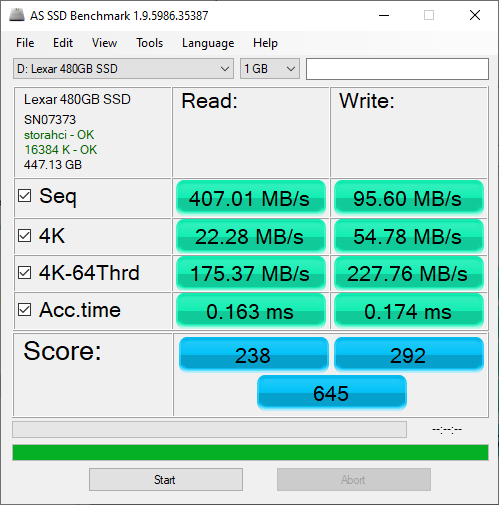
Lexar NQ100 - Dirty
To see how well the NQ100 could recover, I let the computer sit for about 30 minutes and then reran the test. The drive wasn't able to reach the factory fresh performance shown in our earlier tests. However, its sequential write speed jumped up to 426.20 MB/s.

Lexar NQ100 - After TRIM
Lastly, I used Parted Magic to perform a secure erase on the NQ100. With the drive wiped clean, it had average read and write speeds of 531.55 MB/s and 496.40 MB/s, respectively.

Lexar NQ100 - Secure Erased
Final Thoughts:
Lexar's NQ100 SSD is a great choice for the consumer looking for an easy and affordable way to improve the performance of their existing desktop or notebook computer. This entry-level, DRAM-less drive combines Lexar's DM928 controller with Micron's TLC NAND flash to deliver a fast and responsive computing experience at a price that won't break the bank. In our sequential read and write tests, the 480GB version of the NQ100 was able to read at speeds as high as 565 MB/s and write at speeds in excess of 514 MB/s. It also did reasonably well in our random write tests, but, for whatever reason, lagged behind many of the other drives when doing random reads at low queue depths.
The NQ100 is available now in 240GB, 480GB and 960GB capacities. Prices on Amazon.com currently range from $34 up to $100, with the 480GB version reviewed here retailing for about $56.

Highs:
- Available in 240GB, 480GB and 960GB capacities
- Equipped with Micron 3D TLC NAND
- Good sequential read and write performance
- Good random write performance
- Shock and vibration resistant with no moving parts
- Reasonably priced
- 3 year warranty
Lows:
- Mediocre random read performance
- DRAM-less
- Does not support hardware based encryption
